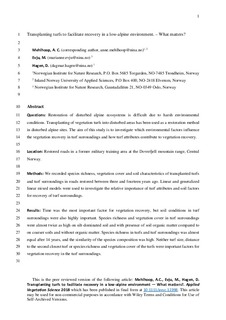| dc.contributor.author | Mehlhoop, Anne Catriona | |
| dc.contributor.author | Evju, Marianne | |
| dc.contributor.author | Hagen, Dagmar | |
| dc.date.accessioned | 2019-03-04T12:17:35Z | |
| dc.date.available | 2019-03-04T12:17:35Z | |
| dc.date.created | 2018-10-15T16:11:46Z | |
| dc.date.issued | 2018 | |
| dc.identifier.issn | 1402-2001 | |
| dc.identifier.uri | http://hdl.handle.net/11250/2588472 | |
| dc.description.abstract | Questions: Restoration of disturbed alpine ecosystems is difficult due to harsh environmental conditions. Transplanting of vegetation turfs into disturbed areas has been used as a restoration method in disturbed alpine sites. The aim of this study is to investigate which environmental factors influence the vegetation recovery in turf surroundings and how turf attributes contribute to vegetation recovery. Location: Restored roads in a former military training area, Dovrefjell mountain range, central Norway. Methods: We recorded species richness, vegetation cover and soil characteristics of transplanted turfs and turf surroundings in roads restored between 3 and 14 years ago.Linearandgeneralizedlinearmixedmodelswereusedtoinvestigatetherelative importance of turf attributes and soil factors for recovery of turf surroundings. Results: Time was the most important factor for vegetation recovery, but soil conditions in turf surroundings were also highly important. Species richness and vegetation cover in turf surroundings were almost twice as high on silt dominated soil and with presence of soil organic matter compared to on coarser soils and without organic matter. Species richness in turfs and turf surroundings was almost equal after 14years,andthesimilarityofthespeciescompositionwashigh.Neitherturfsize, distance to the second closest turf or species richness and vegetation cover of the turfs were important factors for vegetation recovery in the turf surroundings. Conclusion: This study demonstrates the importance of preparing the restoration sites before using turf transplants in road and infrastructure restoration. Of particularimportanceisensuringsoilorganiccontentandafinesoilgrainsizetoincreaserates of vegetation recovery in short time scales. Time is the most important factor for recovery in this ecosystem, and this should be communicated to project owners andtothepublictoensurerealisticexpectationsonrecoverytime. ecosystem management, low-alpine ecosystems, turf transplants, vegetation recovery, vegetation restoration | nb_NO |
| dc.language.iso | eng | nb_NO |
| dc.title | Transplanting turfs to facilitate recovery in a low-alpine environment — What matters? | nb_NO |
| dc.title.alternative | Transplanting turfs to facilitate recovery in a low-alpine environment — What matters? | nb_NO |
| dc.type | Journal article | nb_NO |
| dc.type | Peer reviewed | nb_NO |
| dc.description.version | acceptedVersion | nb_NO |
| dc.rights.holder | This is the postprint version of the article. The published article is available at the website of Applied Vegetation Science | nb_NO |
| dc.subject.nsi | VDP::Zoologiske og botaniske fag: 480 | nb_NO |
| dc.subject.nsi | VDP::Zoology and botany: 480 | nb_NO |
| dc.source.journal | Applied Vegetation Science | nb_NO |
| dc.identifier.doi | 10.1111/avsc.12398 | |
| dc.identifier.cristin | 1620533 | |
| dc.relation.project | Norges forskningsråd: 160022 | nb_NO |
| cristin.unitcode | 209,0,0,0 | |
| cristin.unitname | Høgskolen i Innlandet | |
| cristin.ispublished | true | |
| cristin.fulltext | postprint | |
| cristin.qualitycode | 1 | |
